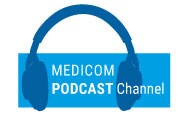Currently, sphingosine 1-phosphate (S1P) modulation is being assessed for different indications in immune-mediated inflammatory diseases [1,2]. The phase 2 placebo-controlled ADVISE trial (NCT04162769) is the first to test the oral S1P1,4,5 modulator etrasimod for safety and efficacy in treatment of atopic dermatitis (AD) [1]. “Etrasimod disrupts immune cell trafficking to skin including multiple types of lymphocytes such as B cells, T cells, and eosinophils, thus reducing inflammation in the skin,” explained Prof. Emma Guttman-Yassky (Icahn School of Medicine at Mount Sinai, USA).
ADVISE included 140 patients with moderate-to-severe AD that were treated in 3 different groups over 12 weeks with placebo, etrasimod 1 mg, or etrasimod 2 mg and followed up for 4 weeks more. After that, an open-label extension with all patients on 2 mg of etrasimod started that is still in progress. “In terms of demographics, the groups were highly balanced, but I want to point out that severity in the vast majority of patients was moderate,” Prof. Guttman-Yassky pointed out. The mean age was 42.5 and 61.4% were women.
The primary endpoint was defined as the rate of change in Eczema Area and Severity Index (EASI), whereas the key secondary endpoint was the percentage of patients achieving a validated Investigator Global Assessment (vIGA) of 0 or 1 (i.e. clear or almost clear) and a ≥2-point change from baseline at week 12. Additional patient-reported outcomes included weekly Peak Pruritus Numeric Rating Scale, Dermatology Life Quality Index (DLQI), and Patient-Oriented Eczema Measure (POEM).
Overall, the results showed a better performance of the 2 mg dose of etrasimod with improvements in physician-reported as well as patient-reported outcomes compared with placebo. At week 12, 29.8% on 2 mg of the study drug reached vIGA 0/1 (P<0.05 vs placebo). Furthermore, the peak pruritus gradually decreased under etrasimod 2 mg with 42.1% improving ≥4 points. DLQI amelioration was significant with DLQI decrease ≥4 points in 85.7% (2 mg dose) of patients. As for POEM, significance was achieved in both the 1 mg and the 2 mg group.
Etrasimod was well tolerated, no serious adverse events occurred, and no new safety issues emerged. Among the adverse events that occurred in ≥5% of patients, nausea, constipation, back pain, and dizziness were reported more often in the etrasimod 2 mg than in the placebo group. A grade 1–3 decrease in lymphocytes in 8 etrasimod cases was interpreted as an on-target effect that probably presented a beneficial therapeutic impact of etrasimod. “These results support the rationale of S1P1 modulation as a potential new mechanism of action and oral treatment for our patients with AD,” concluded Prof. Guttman-Yassky.
- Guttman-Yassky E, et al. Etrasimod, a novel, oral, selective sphingosine 1-phosphate receptor modulator, improves patient and clinician reported outcomes in adults with moderate-to-severe atopic dermatitis in a randomized, double-blind, placebo-controlled phase 2 study (ADVISE). Session S033, AAD VMX 2021, 23-25 April.
- Sandborn WJ, et al. Gastroenterology. 2020;158(3):550-561.
Copyright ©2021 Medicom Medical Publishers
Posted on
Previous Article
« Women at higher risk for dermatologic side effects during immunotherapy Next Article
Bimekizumab superior to secukinumab in psoriasis »
« Women at higher risk for dermatologic side effects during immunotherapy Next Article
Bimekizumab superior to secukinumab in psoriasis »
Table of Contents: AAD 2021
Featured articles
Letter from the Editor
Late-Breaking Abstracts
Small molecule effective in moderate-to-severe psoriasis
Bruton’s tyrosine kinase inhibition promising for pemphigus vulgaris
Bimekizumab superior to secukinumab in psoriasis
Etrasimod – a new mode of action for treatment of atopic dermatitis
Women at higher risk for dermatologic side effects during immunotherapy
Novel easy-to-use foam formulation clears scalp psoriasis in one-third of patients
Anti-cholinergic gel demonstrates superior long-term tolerability and efficacy in axillary hyperhidrosis
Psoriasis – The Beat Goes On
Psoriasis: The treatment armamentarium continues to grow
Psoriasis management in times of COVID-19: the knowledge is growing steadily
Lower burden of high-risk atherosclerotic plaques in psoriasis patients treated with biologics
COVID-19: What Dermatologists Need to Know
Psoriasis and hidradenitis suppurativa during COVID-19: keep calm and carry on
COVID-19 in children – cutaneous involvement is common
Cutaneous reactions after COVID-19 vaccination: an update
Novel Developments in Sun Protection
Sunless tanning and other developments in sun protection
What Is Hot in Atopic Dermatitis
Comorbidity is common in adult and paediatric atopic dermatitis patients
Significant improvements in the system armamentarium for AD treatment
Topical pan-JAK inhibitor cream safe and efficacious in atopic dermatitis
Hairy Matters – What Is New in Alopecia
Allergies: an underrated factor in alopecia pathogenesis
Botulinum toxin A: a contradictory role in hair loss
Platelet-rich plasma in androgenetic alopecia – hype or hope?
Acne – New Developments
New therapeutic options add value to current acne treatment
Nicotinamide and probiotics can support acne therapy
Pearls of the Posters
Related Articles

November 22, 2021
ACR 2021 Highlights Podcast

December 22, 2021
PFGC 2021 Highlights Podcast
© 2024 Medicom Medical Publishers. All rights reserved. Terms and Conditions | Privacy Policy
HEAD OFFICE
Laarderhoogtweg 25
1101 EB Amsterdam
The Netherlands
T: +31 85 4012 560
E: publishers@medicom-publishers.com

